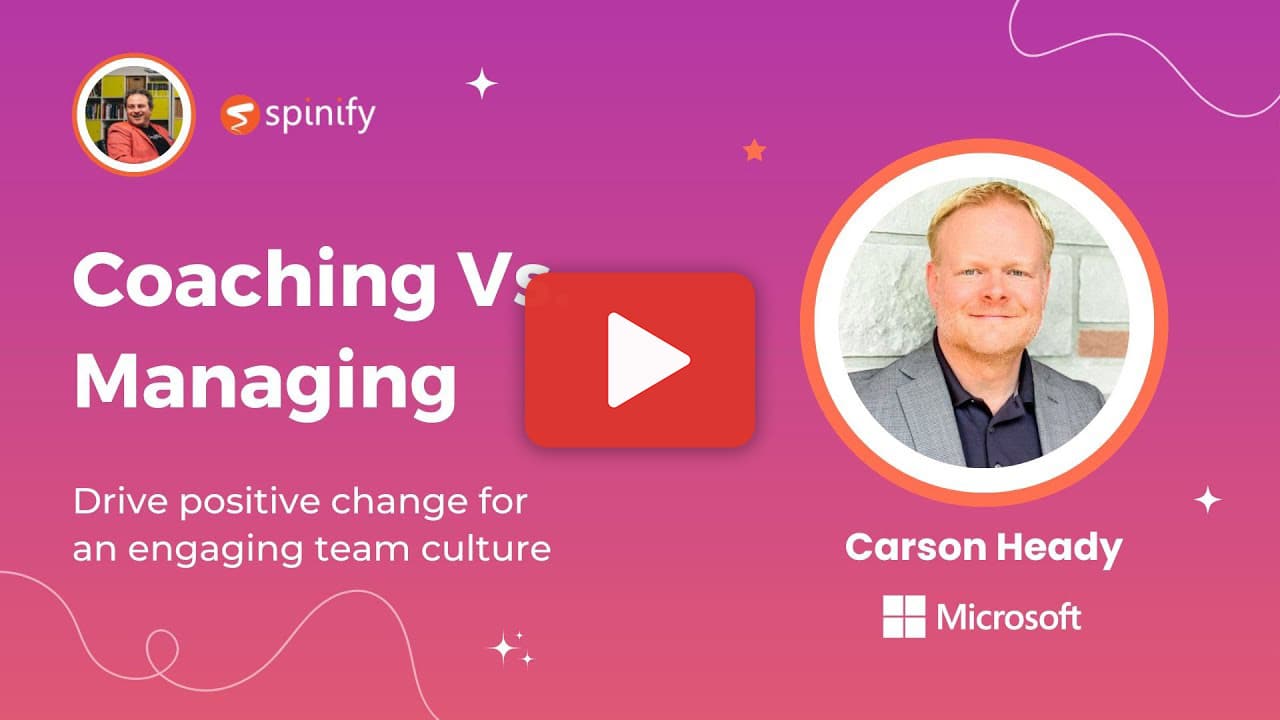We spoke recently to Carson Heady, sales leadership expert at Microsoft and bestselling author of the Birth of a Salesman series, about the contrast between a managing and coaching approach to leadership. If you missed it, you can catch up here!
Of course, there are some key differences between managing and coaching (otherwise, this article would be relatively brief), so let’s pick Heady’s mind on these aspects of sales training and career development.
Management – Directing the Flow
Heady talks about managers “directing the flow” in terms of how work under their purview gets done. Management is inherently workflow-specific and task orientated. It doesn’t matter exactly who completes a task, so long as everyone works well together. What matters in good management is that the work gets done, to an exacting standard, on time, and within budget.
Heady further contrasts management from leadership thus: “where leaders are at the front… pulling things or helping their team push, … a manager is articulating, ‘here’s the plan, here’s what you need to go do.'” Whereas leaders lead by example, managers lead by shaping strategy.
Coaching – Developing People
In coaching, it very much does matter how much the individual you’re guiding contributes. While management can be thought of as task-focused, coaching is extremely people-centric.
Says Heady, “when I think of the word ‘coach,’ I think of the great sports coaches … that great, motivational aspect.” He goes on to suggest that this is where managers sometimes struggle to make the leap to great leadership. With coaching, understanding, and encouragement take the place of monitoring and directing.
The Importance of Sales Coaching
Sales coaching is critical, says Heady. One of the biggest complaints about poor sales managers is that they’re not providing their staff opportunities for improvement and development through coaching.
While managers may focus on accountability and take a target-driven approach, a coach will “get into the trenches with their team” and find out what’s really going on, then ascertain what would motivate better performance. A work coach takes an overview of the field of play and develops strategy, just as a sports coach would in a traditional team setting.
Building a Coaching Culture
For a coach to make a difference in a sales team, they need to develop a receptive team culture. “In order for a coach to build and nurture a culture,” explains Heady, “it starts with the people, it starts with the team and the culture, and what matters.”
Not all teams are alike; it is implied. Some will be motivated by money and status, some by exceeding targets, and others by building a supportive workplace where individuals excel and progress. As ever, it’s complicated, and as Heady points out, “the only constant is change.”
A good coach will be keenly aware of what matters to a team and the individuals who make up that team. They will be neither reactive nor reactionary. Says Heady of his own experience in a coaching role: “we’ll work through problems together,” and he stresses the importance of consistency of approach: “keeping that steady hand on the wheel.”
Key elements of defining and nurturing a culture conducive to coaching:
- Being proactive and getting your hands dirty.
- Avoiding assigning blame as a punitive act.
- Working through problems collaboratively
- Consistently investing in your team.
- Staying on the mission, with everyone buying in.
Taking this in-depth approach requires time. Heady suggests that “over half your time should be spending time with your team.”

Techniques for Effective Coaching
Heady recommends beginning by surveying what individuals want to get out of a coaching relationship. This includes such practicalities as the frequency of meetings, what topics are open to discussion, and what career aspirations individuals have. This process creates a blueprint you can return to periodically to ensure the coaching process is fit for purpose.
“A coach is the evangelist and the advocate of their employees,” says Heady. This means that a coach needs to get to know the workers under their charge intimately. Heady will typically take a lot of notes in the initial meeting to clearly understand any issues blocking or limiting success. The picture he builds will also allow him to articulate the state of play to leadership so that they, too, recognize and reward the effort being made.
Relationships and Resources
Heady believes that two aspects of coaching are critical – relationships and resources, or, to put it another way, people and process. A salesperson can only thrive if they have built the right relationships (with clients, colleagues, managers, and coaches) and have the necessary tools at their disposal (leads, systems, strategies). Heady would typically stress these two aspects to any new charge under his tutelage.
Experienced team members may require a different approach, especially those who may have preconceptions and expectations. Heady needs to know these before shaping his coaching approach appropriately. With an experienced salesperson, it may be more about developing a particular muscle or bolstering an area of weakness. A mentor could be instructive to help such a person progress to the next career level.
Service not Overhaul
Something commonly misunderstood about the coaching process is that it’s rarely about making “a drastic overhaul of anyone’s process, whether it’s someone very new or tenured.” Small tweaks to process can be highly effective, Heady explains.
However, when a significant change is necessary, perhaps due to the vicissitudes of the market, it’s essential to appreciate that people will be naturally resistant. They will need to appreciate the reason behind process changes. A good coach can facilitate that.
An effective way of breaking down resistance to change might be to ask, “if you’re not 100% satisfied with the results you have, why are you so afraid to gamble them?”
It’s not just about understanding the reason for a change; it’s also about committing to it. This means that a coach may be in it for the long haul to ensure a change really beds in.
How do You Ensure Training Actually Sticks?
It can be all too easy to fall back into bad habits, those comfortable systems employees are familiar with, even if they don’t 100% work. Heady believes there need to be regular touchpoints following a process or systems change as well as tangible, trackable measures of success. In other words, objectives, and goals need to be SMART to cite a tried and tested formulation (specific, measurable, achievable, relevant, and time-bound).
Concrete metrics and KPIs are necessary. A key example might be prospecting, where it may be useful to set minimums for approaches to potential new clients since this is an especially challenging but vital part of sales. Looking more closely at results and changing messaging accordingly or otherwise altering the process can be highly instructive and effective. In short, employees learn from the data relating to their performance.

How do You Identify who is Coachable?
Heady has a very interesting answer to this conundrum. How can you tell who can effectively be coached in a large team? To identify likely candidates, Heady asks, “what have you learned from your greatest losses, and how did you bounce back?” This question reveals which employees are most honest, introspective, and resilient. These will usually prove the most malleable and coachable.
People who are more collaborative and actively want to learn and grow prove easiest to work with. Dealing with a setback is very character-building and demonstrates determination, which stands learners in good stead. “I don’t think any of us are ready for a promotion until we’ve been kicked in the teeth, sometimes multiple times,” explains Heady, “because that shows the resilience you have.”
What Makes a Successful Rep a Great Coach?
The most successful reps aren’t necessarily the best coaches or managers. As Heady points out, to be a great leader, you must exchange being the “great hero” for the “great hero-maker.” It can be a difficult transition because salespeople are often driven by ambition and regular recognition. In contrast, a coaching role is about inspiring others and giving back, a very different kind of reward.
Even with a large team, it’s not enough to institute a “one size fits all” process fix. Coaching, unlike management, is more about finding out how salespeople currently work and helping modify that methodology for improved success. It is a collaborative approach, not a top-down, ego-driven one.
A manager adopting a coaching approach doesn’t succeed unless their team does.
Coaching is Clear Communication
Heady talks about his own formative experience of being well-coached when he was given clear, honest feedback, which made him understand the “why” behind a problem. Sometimes the why is more than simply achieving goals or hitting targets. Sometimes it’s about helping employees maximize their positive impact to increase their compensation package, to cite one example. That’s not something a manager might commonly focus on, but a coach certainly should.
Transparent, communicative management was something that Heady says “happened rarely” in his career but always made a significant impact.
How can a Coach Maximize the Recognition an Employee Feels?
It’s important to “recognize in the moment,” as Heady explains. Rather like parenting, he looks for reasons to give compliments and reinforce success through positivity. Simply praising an employee for a well-written email or beginning meetings with a “DJ of the week” (an employee who has scored a win gets to choose a motivational track to play) can motivate.
Recognize achievement often and regularly, suggests Heady, and make this a habit (even one you calendarize). Heady uses gamification strategies to reinforce a sense of achievement; they are popular and effective motivators.
What’s the Best Ratio for Coach to Sales Team?
This is a tricky question, but the answer depends on the team’s cohesion, overall skill level, and the specific needs of each group. 10-20 is generally ideal, Heady suggests.
How do You Ascertain Coaching Effectiveness?
Obviously, there can be improvements in team performance metrics. However, coaches must also decide upon individual success metrics for each rep. There is no uniform diagnosis, so there can be no uniform approach for a given individual. Taking notes and returning to them at regular intervals is vital.
The flip side is knowing what to do when things aren’t working. Heady says you need to ascertain whether it’s a “skill or will” mismatch. In other words, is the individual simply having major difficulties, although trying, or are they simply unwilling to change?
Again, returning to the notes agreed upon initially is essential. The coach and employee have made a sort of contract, so it’s important to know if it’s being adhered to and, if not, why not? If refusal to make changes is ongoing, then it may be time to adopt a more disciplinary approach. Such refusals will be rare; however, most employees value the opportunity to be coached and improve over time.
Coaching is not Friendship
When individuals begin coaching, it can be tempting to try to become beloved by the team in question, to adopt a sort of collegiate role. Heady warns that “your organization is paying you to be the ambassador of their brand and the evangelist of your team.” However, this does not require a coach to pull any punches or let anyone off the hook.
The team being coached is not a coach’s friend, and the coach will move on when their job is done, in other words. This does not mean a coach cannot care or invest energy and time, but it is crucial to maintain a professional distance to be able to remain objective and effective. Ultimately, this is a more respective approach than trying to be everyone’s buddy.
The Bottom Line
To be the best Coach, you need the best tools. That’s where Spinify comes in. Using our comprehensive coaching toolkit, you can help inspire and shape the best team possible!
Book your free, personalized demo today and see how easy it is to build your dream team with Spinify.
More Resources from Carson Heady
If you want to learn from Carson Heady, check out his book “Salesman on Fire” and his Spotify podcast, Social Selling for Newbies.




